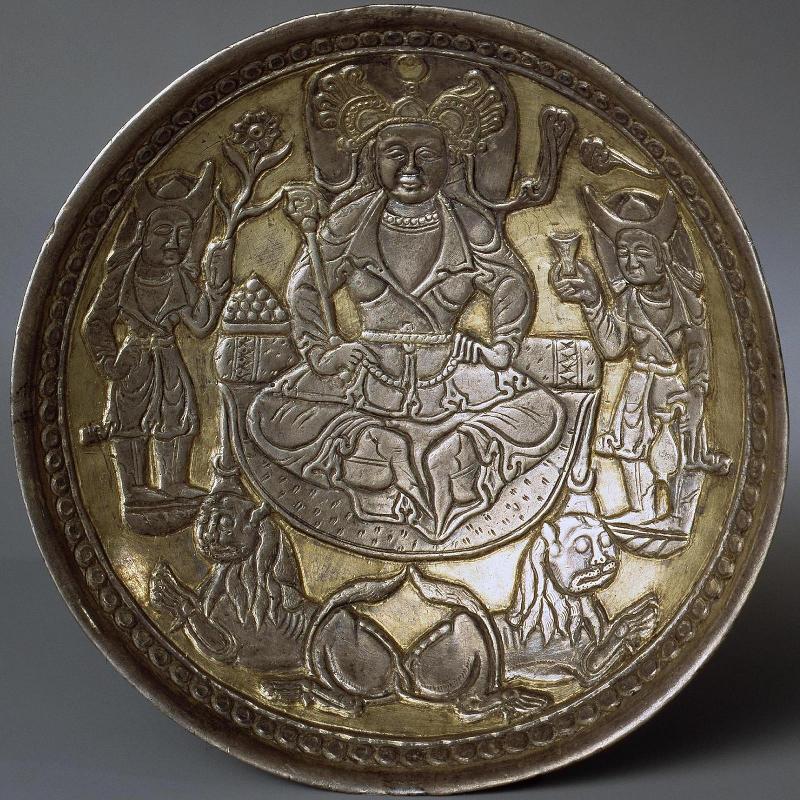Create an Amazon Wedding Registry

Try Amazon Fresh
Silver Bowl,
from Iran or Afghanistan, 11th century,
Hermitage, St. Petersburg

A larger image of the Silver Bowl from Iran or Afghanistan, 11th century, Hermitage, St. Petersburg, S-499
Title: Small Dish
Place of creation: Iran or Afghanistan
Date: Early 11th century
Material: silver
Technique: cast, carving
Dimensions: height: 2cm; diameter: 10.3 cm
Acquisition date: Entered the Hermitage in 1953; handed over by the State Purchasing Commission; purchased from a private person
Inventory Number: S-499
Category: Applied Arts
Collection: Oriental Art
The State Hermitage Museum
Referenced as Plate 84 on pp.200-201, Moya Catherine Carey, Painting the Stars in a Century of Change: A Thirteenth-Century Copy of Al-Ṣūfīís Treatise on the Fixed Stars (British Library Or. 5323) (Thesis University of London, 2001).
The drapery style continued in a less adulterated form in Iran itself. So much is clear from the 1009-10AD al-Ṣūfī manuscript, and a contemporary silver dish, attributed to early eleventh century Iran or Afghanistan [1009-10 An Oxford al-Ṣūfī Bootes, early eleventh-century silver bowl- PLATES 70A, 84].108 Together, these two artefacts demonstrate the continuity of this distinct Iranian style up to the eleventh-century. Three engraved and repoussť figures resemble the 1009-10 AD Oxford illustrations in
almost every detail of costume.109 This shows that the style was still current when al-Ṣūfī's treatise was illustrated for the first time, although it was soon to disappear from general decorative use.
108 State Hermitage Museum, St Petersburg, inv.S-499. Cf. also two other early Islamic silver bowls: a 658AD silver bowl from Khwarazm (British Museum OA 1975.5-16.1: PLATE 79A), and a seventh-century AD (?) silver bowl (Walters Art Gallery, Baltimore; reproduced in Wellesz 1959 fig.38).
109 All three figures wear knee-length v-neck robes, wrapping across the body, with a round-necked undershirt beneath. Bell-shaped gathers fall from the waistline and form along the skirt-hem, and a small gather flares out to the side on two of the figures. On the sleeves, drapery-folds collect at the wrist. The ruler's robe consists of a short skirt over a longer one. The main figure wears a Sasanian style crown.
59. Saucer.
Silver, gilding. Diameter 10.3. Eastern Iran, early 11th century
Found in Yamgort in the Yamalo-Nenets National District. Stored in the State Hermitage, inv. No. S-499.
The saucer depicts a king on a throne between two servants in two-horned hats, which in the XI-XII centuries was worn by the courtiers of the Ghaznavid dynasty (cf. cat. No. 34).
The saucer, like the well-known coin-like medal with the same plot, apparently belonged to the gifts handed out by the sovereign on the occasion of some solemn event.
Such an event could be, for example, the proclamation of Mahmud Ghaznevi in 1000 as the "king of the East."
Details of clothing and utensils find analogs in the works of the 11th century, while in technique (sampling of the background) and in a number of details,
the saucer goes back to the Khorasan (East Iranian) silver of the beginning of the 9th century.
Attention is drawn to the Mongoloid face of the king - Turkic by origin.
The Ghaznavids are the descendants of a Turkic slave-guard who seized the territory of Afghanistan, Khorasan and part of India.
On the round bottom outside have been scratched Siberian drawings of birds (the so-called "teteri").
Found in a hoard with local and Volga-Bulgarian items.
Source: Plate 59, "Treasures of the Ob Basin." Formika. 1996.228
See a similar composition on a Post-Sasanian silver-gilt plate from the Kama region. Enthroned ruler drinking with attendants and musicians. Central Asia or Eastern Iran, 7th to 9th centuries.
See also Plates with figures from Persia and Central Asia
Marble panel with man and monkey, Ghaznavid, early 12th century. Linden Museum, Stuttgart, Germany.
Other 11th Century Illustrations of Costume & Soldiers


